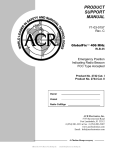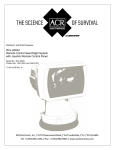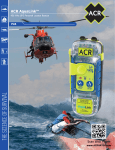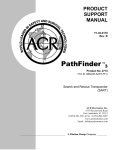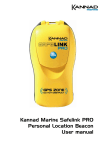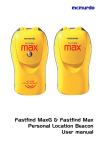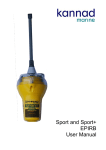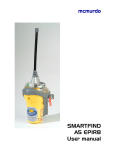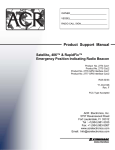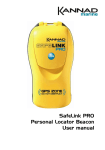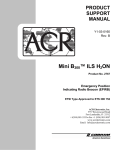Download ACR Electronics ResQMate Y1-03-0240A User's Manual
Transcript
Available for sale in Australia and New Zealand only OWNER VESSEL RADIO CALL SIGN UIN # CAUTION: Before proceeding to install, test or use your new ACR Electronics’ product, please read this Product Support Manual in its entirety. If you have questions regarding the contents of the manual, please contact our Technical Service Department at ACR Electronics, Inc., Telephone +1 (954) 981- 3333. Please be ready to provide the technician with the page number you wish to discuss. If you have a question that is not covered in the manual, please visit our website and access the Frequently Asked Questions (FAQs) section for further information or call our Technical Service Department. The website address is www.acrelectronics.com. If in the future you lose this manual, you may access and print a replacement on the ACR website. Table of Contents STEP ONE - REGISTERING YOUR BEACON ____________________________ 3 STEP TWO - HOW THE BEACON WORKS _____________________________ 6 STEP THREE - INSTALLING THE BEACON_____________________________ 12 STEP FOUR - MAINTAINING THE BEACON ___________________________ 14 APPENDIX A - THE COSPAS-SARSAT SYSTEM __________________________ 17 APPENDIX B - TECHNICAL SPECIFICATIONS ___________________________ 18 APPENDIX C - WARRANTY, USEFUL LIFE POLICY, NOTICES _______________ 19 PLEASE READ ALL WARNINGS, CAUTIONS AND NOTES CAREFULLY Y1-03-0240A 2 STEP ONE - REGISTERING YOUR BEACON 1. Why is registration important? As the owner of this 406 MHz beacon, it is mandatory that you register it with the EPIRB national authority of your country: It is the law. Please note that all 406 MHz beacons are required to have their registration updated every two years by the owner. HOW REGISTRATION WORKS: All 406 MHz beacons transmit a Unique Identifier Number (UIN) when activated. This UIN is programmed into the beacon based on the country in which the beacon is registered, thus authorities are able to determine which country’s database will have your registration information. SAR forces will have information as to who you are as the owner of the beacon, the name and type of vessel that you have, your homeport, and who to contact that might know of your current situation - but only if your beacon has been properly registered. Valuable search and rescue resources are wasted every year responding to false alarms, and registering your beacon helps to resolve false alarms quickly. Y1-03-0240A 3 2. How do I register? Registration in Australia The national authority that accepts registrations in Australia is the Australian Maritime Safety Authority (AMSA). Here are two ways to register: 1. The fastest and easiest way to register is online at www.beacons.amsa.gov.au/beacons. 2. Fill out the enclosed registration form and post, fax or email your form to: Australian Coded Beacons Beacon Registration Section Australian Maritime Safety Authority GPO Box 2181 Canberra City ACT 2601 Australia Phone: 1 800 406 406 or +61 2 6279 5766 Fax: 1 800 406 329 or +61 2 9332 6323 Email: [email protected] NOTE: Do not confuse the registration form with the ACR Electronics warranty card. All registration forms will be entered in the 406 MHz beacon registration database within 48 hours of receipt. The information you provide on the registration form is used for rescue purposes only. A confirmation letter, a copy of the actual registration and a proof-ofregistration decal will be mailed to you within two weeks. When you receive these documents, please check the information carefully, and then affix the decal to your beacon in the area marked “BEACON DECAL HERE.” If you do not receive confirmation back in the expected timeframe, call for assistance. Registration in New Zealand The national authority that accepts registrations in New Zealand is the Rescue Coordination Centre New Zealand (RCCNZ). Here are two ways to register: 1. The fastest and easiest way to register is online at www.beacons.org.nz/406-registration.aspx 2. Fill out the enclosed registration form and post, fax or email your form to: Y1-03-0240A 4 Rescue Coordination Centre New Zealand P.O. Box 30050 Lower Hutt 5040 New Zealand Phone: +64 4 577 8033 or 0800 406 111 Fax: +64 4 577 8041 Email: [email protected] NOTE: Do not confuse the registration form with the ACR Electronics warranty card. All registration forms will be entered in the 406 MHz beacon registration database within 48 hours of receipt. The information you provide on the registration form is used for rescue purposes only. A confirmation letter, a copy of the actual registration and a proof-ofregistration decal will be mailed to you within two weeks. When you receive these documents, please check the information carefully, and then affix the decal to your beacon in the area marked “BEACON DECAL HERE.” If you do not receive confirmation back in the expected timeframe, call for assistance. Y1-03-0240A 5 STEP TWO - HOW THE BEACON WORKS 1. How your beacon brings help 406 MHz beacons are a type of portable emergency equipment that transmits a distress signal to search and rescue (SAR) organizations. The purpose of these beacons is to aid SAR teams in tracking and locating ships or individuals in jeopardy as rapidly as possible. The 406 MHz frequency is a worldwide dedicated emergency frequency that is detected by a special system of satellites called the Cospas-Sarsat system. This satellite system was established by, and continues to be supported by, its primary benefactors - the USA, Russia, Canada and France. The CospasSarsat system has saved over 24,500 lives - and counting - since its inception. See Appendix G or the Cospas-Sarsat website for more information about the system at www.cospas-sarsat.org. When a 406 MHz beacon is activated, the digital distress message is sent to Cospas-Sarsat satellites and, in turn, the distress message is relayed to SAR. The distress message contains important information about the beacon and its owner. Additional information about the beacon is accessed by SAR from the beacon registration database. At the same time the 406 MHz signal is activated, a 121.5 MHz signal is turned on. The 121.5 MHz signal is used by SAR to home in on the beacon as they approach it. The 406 MHz signal is detected by multiple satellites and from that information the location of the beacon can be calculated. This data alone is sufficient for SAR to find persons or ships in distress in a reasonable timeframe. Y1-03-0240A 6 2. Anatomy of your beacon NOTE: When unpacking your beacon, it is recommended that you save the original packaging for re-use when shipping the beacon for battery replacement in the future. antenna strobe light red/green LEDs manual activation switch battery housing // Activation switch with Witness Tab The activation switch embodies a special, patented method of activating a beacon. Refer to a subsequent section of this manual for how to activate the beacon. Y1-03-0240A 7 Switch Positions OFF/ READY position (down, front) TEST position (upright) ON/ TRANSMITTING position (down, back) Manual release bracket antenna hook Front cover release tabs Y1-03-0240A 8 3. Activating your beacon WARNING: This transmitter is authorized for use only during situations of grave and imminent danger. Deliberate misuse may incur a severe penalty. Overview Class 3 beacons can always be manually activated in or out of their bracket. The beacon and bracket are designed to allow the user to perform periodic testing while the beacon is in its bracket. Class 3 beacons-Manual deployment and activation Class 3 beacons can be manually deployed by removing the beacon from the bracket. Once removed, the beacon can be activated by lifting the Activation Switch to a vertical position, sliding it toward the antenna and pushing down to the opposite side of the beacon. Activating the beacon in this manner breaks off the Activation Witness Tab and allows the switch to properly seat, showing the “ ▌ “ symbol (ON). A Class 3 beacon MANUALLY activates with the following sequence: 1.) Remove the beacon from its bracket 2.) Activation method: // Lift the switch to a vertical position // Slide the switch toward the antenna // Push the switch down to the opposite side of the beacon (see illustration below) Class 3 Beacons - Manual Activation Without Deployment The beacon can be manually activated while still in its bracket by placing the Activation Switch in the ON position. Y1-03-0240A 9 Push the main switch up 90 degrees, slide toward antenna and all the way down to activate. Witness tab will break once placed in the “ON” position TIPS FOR OPTIMUM DEPLOYMENT OF AN ACTIVATED BEACON: When activating and deploying your beacon in an emergency, DO NOT: // Activate the beacon if you have any other means of self rescue. // Hold or clutch the beacon or antenna. // Operate the beacon while hand held, if at all possible. // Turn the beacon off for any reason, including to save power. // Operate the beacon inside a life raft or under any other canopy or cover. When activating and deploying your beacon in an emergency, DO: // Follow the steps to activate the beacon as described on the beacon or in this manual. // Manually activate the beacon. // Give clear view to the sky. // Take the EPIRB with you if abandoning ship, provided there is time to get it. // Tether beacon, using the lanyard, to the life raft and let the beacon float (if in a life raft). // Keep EPIRB upright for best signal transmission, either by floating it, resting it or holding it in this position. Y1-03-0240A 10 4. Turning off the beacon If your beacon was manually activated and you wish to deactivate, return the thumb switch to the “OFF” position. If deactivation should fail, remove the four screws holding the unit together and unplug the battery to disable the unit. Return the beacon to ACR Electronics for service. 5. False alarms To prevent false alarms, it is important to be aware of how your beacon can be activated. A ResQMate™ 406MHz Class 3 EPIRB can be activated by: // When the switch is moved to the “ON” position, in or out of the bracket, the unit will start transmitting Reporting Should there be, for any reason, an inadvertent activation or false alarm, it must be reported to the nearest search and rescue authorities. The information that should be reported includes: // The EPIRB 15-digit Unique Identifier Number (UIN) // Time and date // Duration and cause of activation // Location of beacon at the time of activation To report false alarms, contact any of the following: Region/Authority Telephone Number Australia/ RCC Australia 1800 641 792 New Zealand/ RCC New Zealand 0508 472 269 Y1-03-0240A 11 STEP THREE - INSTALLING THE BEACON 1. Mounting location The selection of a mounting location will vary from vessel to vessel. Beacons should be protected from outside influences while being readily accessible at all times in the event of an emergency. The location selected must be sufficiently rigid to support the weight of the total installation. Hazards to avoid when selecting a mounting location: // Vibration // Exposure to the elements // Possibility of impact from hatches, gear, or personnel // Harmful vapors // Exhaust // Harsh chemicals // Locations that can be obscured by foreign articles on a temporary or permanent basis. CAUTION: Manual release brackets must be mounted in a protected location that is easily accessible should it be necessary to abandon ship. The bracket can be mounted on a vertical surface with the beacon antenna pointing skyward or a horizontal surface with the beacon face up. Avoid mounting locations that subject the bracket to breaking waves. Avoid mounting locations that do not provide protection from harmful UV rays of the sun. The bracket must be mounted facing inboard to avoid being lost overboard due to impacts of breaking waves, personnel or loose gear. Visually inspect the area surrounding the mounting bracket installation site for hidden hazards or obstacles that may have been overlooked during the location selection. If there is any doubt as to the ready accessibility to the beacon at all times or if any condition may appear to be questionable, conduct a complete and thorough investigation before final approval of the installation. NOTE: When selecting the beacon bracket location, be sure to consider the requirement for four screw holes to secure the bracket. CAUTION: Keep this beacon a safe distance away from all magnetic sources. Magnet safe distance is 4.6 ft or 1.4 m, including the distance from stereo speakers Y1-03-0240A 12 2. Manual release bracket Manual release brackets are designed to hold the beacon securely in place. The beacon must be manually deployed. The bracket can be mounted on a vertical flat surface with beacon antenna up or on a horizontal flat surface facing skyward. This location must be easily accessible in order to manually deploy the beacon or to perform the required maintenance and functionality tests. Typical locations include near the helm station or just inside the companionway door. The manual release bracket has four pre-drilled screw holes to use for securing the bracket to a flat surface. Remove the beacon from the bracket. To do this while holding the assembly, lift the latch to release bracket pressure from the beacon. The beacon will slide up and out of the bracket. On either side of the bracket are release tabs. Simultaneously depress each tab to separate the bracket from the mounting block. The mounting block can be held in place to mark the placement of the screw holes or you can use the mounting template provided. The use of #8 pan head stainless steel fasteners and washers (not included) is recommended. Be sure to confirm that fasteners will not contact any wires or plumbing before drilling pilot holes. Mounted to wall LATCH OPEN Y1-03-0240A LATCH CLOSED 13 STEP FOUR - MAINTAINING THE BEACON 1. Safety DOs and DON’Ts On a routine basis aboard ship, DO NOT: // Hold or carry the beacon by its antenna // Mount the beacon in its bracket close to large structures or magnetic areas // Tie the lanyard to the EPIRB bracket or any other structure // Obscure the beacon by placing objects in front of it On a routine basis aboard ship, DO: // Mount the beacon in its bracket in an obvious location, so that all can see it // Mount the beacon in its bracket with the rolled lanyard facing inward (facing the bracket) // Follow the recommended maintenance schedule // Perform a beacon Self-Test monthly // Follow up with beacon service if Self-Test fails 2. Routine beacon maintenance At least every ninety days, the manual release bracket and beacon should be inspected for deterioration and/or residue buildup that may affect the function of the beacon. Part of the visual check includes checking the antenna for tightness. Clean the beacon and the mounting bracket to remove any residue buildups. It is recommended that the beacon and mounting bracket be wiped with a damp cloth. Carefully inspect the beacon case for any visible cracks. Cracks may admit moisture, which could falsely activate the beacon or otherwise cause a malfunction. Any cracks observed should immediately be referred to ACR Service for evaluation. Call ACR Electronics Technical Service +1 (954) 9813333. 3. Battery replacement Battery replacement is due 5 years from date after the beacon placed into service, or by expiry date on the beacon whichever is first. During each inspection, check the time remaining until battery replacement is required. The battery must also be replaced if the beacon has been activated for any use other than the Self-Test. Y1-03-0240A 14 Always refer battery replacement and any other beacon service to a factory authorized Service Center. Find a Center near you at http://www.acrelectronics.com/brc.htm. Battery replacement includes servicing the beacon by replacing all o-rings, testing the water seal and the electrical properties and doing a full functional test on the unit. NOTE: There are no user serviceable items inside the beacon. Do not open the beacon except to disable (in case of faulty or accidental activation). Otherwise, always have the beacon serviced. WARNING: Battery contains lithium To avoid possible fire, explosion, leakage or burn hazard, do not open, recharge, disassemble or heat beacon above +70ºC (+158ºF) or incinerate. These products contain lithium in the battery. Various beacons may or may not require special shipping instructions due to the lithium batteries and changes in shipping regulations. Shipping of hazardous materials requires special handling and documentation. MSDS sheets, along with shipping information, can be found on our website at http://www.acrelectronics.com/hazmat/default.htm. In the case of the ResQMate™, the product contains small batteries that are non-hazardous. However, regulations can change. Be advised that it is best to verify the shipping requirements at the time you are preparing to ship the unit. 4. Changing ownership or contact information As the owner of the beacon, it is your responsibility to advise the national authority of any change in the information on the registration form. If you are transferring the beacon to a new owner, you are required to inform the national authority. You can do this by using their online database or by letter, fax or telephone and informing the authority of the name and address of the new owner. The new owner of the beacon is required to provide the national authority with all of the information requested on the registration form. This obligation transfers to all subsequent owners. The new owner may contact his local authority for the necessary form(s). 5. Lost or stolen EPIRBs If your EPIRB is lost or stolen, do the following immediately: // Report to your local authorities that the EPIRB has been lost or stolen // Contact your national authority, with the following information: o Police department name o Police department phone number o Police case number If your EPIRB were to be activated, the information you provided will be forwarded to the appropriate search and rescue authorities who will ensure Y1-03-0240A 15 that your EPIRB gets back to you. If someone attempts to register an EPIRB reported as stolen, your national authority will notify the appropriate police department. Visit www.cospas-sarsat.org for more detailed information. 6. Servicing the manual release bracket To remove a beacon from the bracket, lift the latch and release the pressure from the beacon. The beacon will now be able to slide upwards out of the bracket. It is not anticipated that the bracket will require servicing other than periodic cleaning. Brackets are a key part of the overall beacon system. They hold a beacon ready for deployment while preventing false alarms. NOTE: Whenever a beacon is returned for service, it must be accompanied by the bracket. 7. Self-testing the beacon The RLB-40 beacon may be self-tested up to a maximum of sixty times in the five-year life of the battery, or once per month for the life of the battery. Selftests can be performed randomly, however, ACR recommends that you perform the Self-test on a once per month schedule. Do not exceed the limit in order to conserve the battery for emergency use. The functional Self-test is initiated by momentarily lifting the Activation Switch to a vertical position and holding it in this position for at least one second and at most four seconds. A beep indicates the initiation of the Self-test sequence. Self-test will check battery capacity and perform five functional tests, which include the battery life, beacon memory, board circuit, 406 RF and strobe test. The last green LED flash and a long beep indicate a successful test. If any of the individual tests fail during Self-test, there will be two beeps and a red LED flash. Self-test will discontinue at that point. NOTE: The “beeps” are a very high-pitched tone that some people may not be able to hear. When performing the Self-test, you may count the green LED flashes. Y1-03-0240A 16 APPENDIX A - THE COSPAS-SARSAT SYSTEM EPIRBs transmit to the satellite portion of the Cospas-Sarsat system. Cospas-Sarast satellites are an international system that utilizes Russian Federation and United States’ low altitude, near-polar orbiting satellites (LEOSAR). These satellites assist in detecting and locating activated 406 MHz satellite beacons. Cospas-Sarsat satellites receive distress signals from EPIRBs transmitting on the frequency of 406 MHz. The CospasSarsat 406 MHz beacon signal consists of a transmission of non-modulated carriers followed by a digital message format that provides identification data. The 406 MHz system uses satellite-borne equipment to measure and store the Doppler-shifted frequency along with the beacon’s digital data message and time of measurement. This information is transmitted in real time to an earth station called the Local User Terminal (LUT), which may be within the view of the satellite, as well as being stored for later transmission to other LUTs. The LUT processes the Doppler-shifted signal from the LEOSAR and determines the location of the beacon, then the LUT relays the position of the distress to a Mission Control Center (MCC) where the distress alert and location information is immediately forwarded to an appropriate Rescue Coordination Center (RCC). The RCC dispatches Search and Rescue (SAR) forces. The addition of the GEOSAR satellite system greatly improves the reaction time for a SAR event. This satellite system has no Doppler capabilities at 406 MHz, but will relay the distress alert to any of the LUT stations. When there is GPS data included in the distress message, SAR authorities instantly know your location to within 110 yards (100 m). This speeds up the reaction time by not having to wait for one of the LEOSAR satellite to pass overhead. Because most of the search and rescue forces presently are not equipped to home in on the 406 MHz Satellite beacons signal, homing must be accomplished at 121.5 MHz. Once the 406 MHz signal is relayed through the LEOSAR and/or GEOSAR network, SAR forces determine who is closest, and then proceed to the beacon using the 121.5 MHz homing frequency. Y1-03-0240A 17 APPENDIX B - TECHNICAL SPECIFICATIONS GENERAL/ ENVIRONMENTAL 17.7 H X 10.67 W X 9.09 D cm (6.97 X 4.2 X 3.58 in) 592 g (20.88 oz) High impact UV resistant polymer ACR-Treuse™ (high visibility yellow) Tested to 10 min @10 m (33 ft), exceeds RTCM standard Buoyant Yes Deployment Manual BATTERY Operational life 48 hours minimum @-20ºC (-4ºF) (Class 2) Battery type and LiMnO2 replacement interval 5 years from date beacon placed in service, or after use in an emergency not to exceed battery expiry Operating temperatures -20º C to +55º C (-4º F to +131º F) (Class 2) Storage temperatures -30º C to +70º C (-22º F to +158º F) (Class 2) 406 MHz TRANSMITTER Frequency 406.037 MHz Power output 5W Digital message format User protocol 121.5 MHz TRANSMITTER Frequency 121.5 MHz Power output 25 mW PEP Modulation type AM (3K20A3X) LED STROBE Light color White Output power 1 cd (effective candela) Flash rate 20-30/ min Range 360º visibility GENERAL Accessories Mounting bracket, ACR P/N 9502 Beacon size (without antenna) Beacon weight Beacon material Color Waterproof Approvals Cospas-Sarsat certificate #189 Meets Class 3 (AS/NZ 4280.1) EPIRB NOTE: For complete information regarding beacon type approvals, please visit ACR’s website at www.acrelectronics.com Y1-03-0240A 18 APPENDIX C - WARRANTY, USEFUL LIFE POLICY, NOTICES 1. Limited Warranty This product is warranted against factory defects in material and workmanship for a period of 1 (one) year* from date of purchase or receipt as a gift. During the warranty period ACR Electronics, Inc. will repair or, at its option, replace the unit at no cost to you for labor, materials and return transportation from ACR. For further assistance, please contact our Technical Service Department at ACR Electronics, Inc., 5757 Ravenswood Road, Fort Lauderdale, FL 33312-6645. Email: [email protected], Fax: +1 (954) 983-5087, Telephone: +1 (954) 981-3333. This warranty does not apply if the product has been damaged by accident or misuse, or as a result of service or modification performed by an unauthorized factory. Except as otherwise expressly stated in the previous paragraph, THE COMPANY MAKES NO REPRESENTATION OR WARRANTY OF ANY KIND, EXPRESS OR IMPLIED, AS TO MERCHANTABILITY, FITNESS FOR A PARTICULAR PURPOSE, OR ANY OTHER MATTER WITH RESPECT TO THIS PRODUCT. The Company shall not be liable for consequential or special damages. To place the warranty in effect, register online at www.acrelectronics.com or return the attached card within 10 days. *Five years for the following products: EPIRB, PLB, S-VDR, SSAS. 2. Useful Life Policy The typical service life of a properly maintained Product is limited to 12 years from date of manufacture. Products that are 12 years and 1 month or older from date of manufacture will not be serviced by ACR or our Battery Replacement Centers. A Product that is 12 or less years old from date of manufacture will be serviced as long as the unit appears fit to be placed back into its final operational cycle. Service includes the replacement of those items that must be replaced at service intervals and the verification that the device appears to be in good mechanical and electrical working condition by an ACR authorized service technician. 3. Notices ACR Electronics diligently works to provide a high quality Product Support Manual, however, despite best efforts, information is subject to change without notice, and omissions and inaccuracies are possible. ACR cannot accept liability for manual contents. To ensure that you have the most recent version of the Product Support Manual, please visit the ACR website at www.acrelectronics.com. ©2008 by ACR Electronics, Inc., part of Cobham plc. All rights reserved. Reproduction in whole or in part is permitted only with permission of ACR Electronics, Inc. Ongoing product improvements may change product specifications without notice. Trademarks or registered trademarks are the property of their respective owners. Y1-03-0240A 19


























